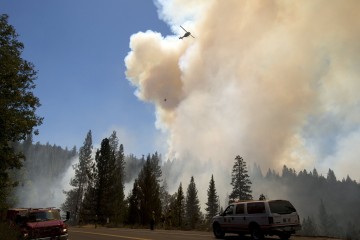
Paul Kitagaki Jr. / McClatchy-Tribune
Fresno State students may have felt more than a tickle in their throats the past few weeks while breathing in the hot Valley air. This time around, allergies are not to blame.
The Rim Fire, the largest fire California has seen this year, was around 75 percent contained around 10 a.m. Tuesday, said Jim Bagnall, a meteorologist with the National Weather Service in Hanford.
Since the fire started in Stanislaus National Forest on Aug. 17, nearly 236,000 acres have been burned and over 100 structures destroyed, including 11 homes.
Bagnall explained that the combination of heat from the fire and the Valley heat allowed the fire to create its own weather system throughout the area. The heat combination created a strong upward motion, allowing the fire to grow at a rapid pace.
Fresno County Fire spokesman Ryan Michaels said the fire’s upward movement makes firefighting difficult.
“On extremely steep terrain, fire has potential to make very fast runs. We can’t move uphill as fast as the fire can,” he said.
The Associated Press reported Sunday that the Rim Fire is the fourth largest fire in California’s history, passing a September 1932 Ventura County fire that burned 219,520 acres. Photographs of the fire from Aqua, a NASA satellite, showed the intense clouds obscuring the ground.
The smoky air triggered an unhealthy air quality warning, which expired early Tuesday afternoon when the wind shifted. “The smoke has been blown to the northeast, away from the Valley, so there is not as much of a risk to residents now,” Bagnall said.
Despite the fire’s severity, Bagnall said there were no long-term effects for residents to worry about. However, he did add that issues would still be present for those in the Valley with pre-existing breathing problems and allergies.
“We recommend that people limit their exposure, and if you absolutely have to be outside, then avoid strenuous activity,” Bagnall said.
Warnings such as these drastically affected tourism in Yosemite National Park, said Mia Chennault, a Fresno City College graduate who has worked in Yosemite Valley as a cashier at the Village Store for the past four months. She said multiple road closures were partially to blame for the decline in visitors.
Chennault said she had several customers in the store who were evacuated from their campgrounds and were trying to find other places to stay nearby. She added that several of her friends were evacuated from their homes in White Wolf, an area closer to the fire.
When Chennault went to work on Saturday morning, she said the smoke obscured the mountains she affectionately considers her pretty walls. “I know the sun is there only because I see this orange ball in the sky,” she said.
Chennault shared photographs of the smoky park on Facebook from her smartphone. One photo was of herself wearing a bandana around her face for protection from inhaling the smoke.
Despite progress in fighting the fire, roughly 4,500 structures and residences still face considerable danger.
“There’s about 5,000 people out there on this one fire,” Bagnall said. “It’s pretty bad.”
Michaels said CalFire crews spend 24 hours on dutyand then the next 24 hours off. He said crews receive their briefing in the mornings and are sent off with the expectation to be self-sufficient for the following 24 hours until they return to the base camp. At the camp they are debriefed, check their equipment and rest for a few hours before they return to work the next morning.
Fires that last several weeks like the Rim Fire has can wear down crew members and are risky for all involved, Michaels said. Crew leaders are expected to pay attention and make sure they keep their crew members as rested as possible.
This kind of teamwork is the key to successfully battling large and long-lasting fires, Michaels said.
“It’s definitely demanding,” he said. “The potential for injuries is always there.”
While there are thousands of firefighters facing the blaze eating away at the forest, Michaels said there are also areas where crew members rest and eat on their short-lived breaks from the front lines.
These accessory positions hold a great deal of responsibility, he said. Groups spend their time preparing meals and time sheets, and they manage radio communications with multiple outside agencies and oversee logistics centers to ensure the necessary tools are available to combat the fire.
“It becomes a small village,” Michaels said. “We need to be self-sufficient.”




